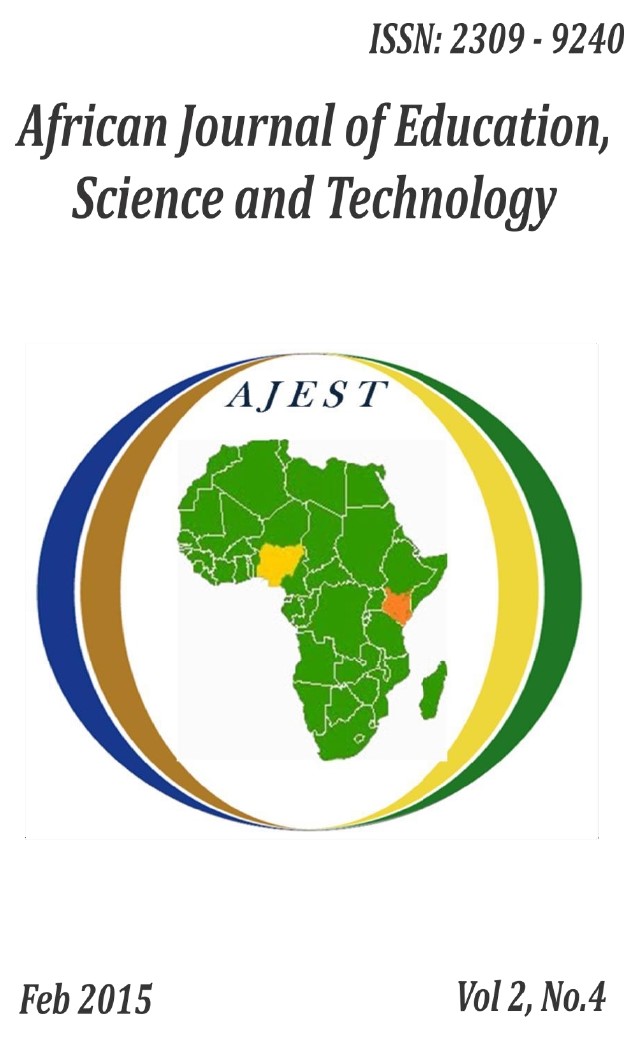Determination of Appropriate Rate and Mode of Lime Application on Acid Soils of Western Kenya: Targeting Small Scale Farmers
##article.abstract##
Western Kenya is experiencing a decline in food production due to increased soil acidity. There is the potential of using agricultural lime, inorganic fertilizers, and Minjingu rock phosphates to address soil acidity problem while promoting food production. Use of lime is still low among smallholder farmers due to lack of awareness on its effectiveness, and the best mode of application. This study aimed at comparing performance of maize under three methods of lime application (spot, band, and broadcast methods) and four rates of application (0, 2, 4, and 6 t/ha), conducted in two districts, Ugenya and Kakamega North of Western Kenya. The on-farm experiment was laid out in a 3 ´ 4 factorial in a randomized complete block design (RCBD) with four replications. All treatments received a blanket application of phosphorus (as TSP) and nitrogen (as CAN) at the rate of 26 kg/ha P and 75 kg/ha N, respectively. There was increase in grain yield with lime application in both districts. Use of any of the methods gave differences in yield between lime rates used. In overall yield, broadcast method was highest in the two district whereas the best rate was using 6 t/ha, due to high lime to soil contact. Application of 6 t/ha of lime by the spot method decreased yield compared to the other method using the same rate due to overliming effects like scorching of seedlings, effects on soil structure, and element toxicities and deficiencies. This was not observed in North Kakamega because of differences in lime requirements of the two districts. Labor required for the application of lime differed with method. Broadcast method was costly because a farmer was required to incorporate lime in the entire plot, while for the other methods, only the applied areas (band rows and hills) are tilled. The broadcast method is expensive due to lime application but gave the best yield response.
References
Cook, R. L,. & Boyd, G. E. (1987). Soil management, a world view for conservation and Production. Canada, John Wiley and Sons.
Guantai S., Steward, P., Ochieng, J. A., Njoka, E., Ogwora, E., Collins, S., & Walker, S. (2007). Kenya maize handbook; ACDI/ VOCA- Kenya training Manual. Nairobi: Modern Lithographics (K) Ltd.
Gudu, S.O., Okalebo, J. R, Othieno. C. O, Kisinyo, P. O., Obura, P.A., & Ligeyo, D. O. (2007) New approach for improving Phosphorus acquisition and Aluminium tolerance of plants in marginal soils; Soil Research Component (2003-2007). Presented at a Workshop in France, October, 2007.
Havlin, J. L, Beaton, J. D., Tisdale, S. L., Nelson, W. L. (2005). Soil fertility and fertilizers; an Introduction to nutrient management (7th ed.). New Jersey: Pearson Education.
Jaetzold, R,. Schmidt, H., Hornets, B., & Shisanya, C. (2005) Farm Management Handbook of Kenya. Vol II/ A West Kenya. Ministry of Agriculture Nairobi, Kenya.
Jaetzoldt, R.,& Schmidt, H. (1983). Farm Management Handbook of Kenya: Natural conditions and farm information. Vol 11/B West Kenya. Ministry of Agriculture, Nairobi, Kenya.
Kanyanjua, S. M., Ireri, L., Wambua, S., &Nandwa, S. M. (2002). Acid Soils in Kenya; constraints and Remedial Options, KARI Technical Note No. 11. Kenya Agricultural Research Institute (KARI) Publication Unit: Nairobi, Kenya.
Kiiya, W., Ndung‘u, F., Onyango, R., Lunzalu, E., & Mulati, J. (2005). Maize Varieties, Soil Fertility Improvement and Appropriate Agronomic Practices. Bulletin supported and funded by the KARI and Rockefeller Foundation.
Likeyo, D. O. (2007). Genetic analysis of maize (Zea mays L.) tolerant to aluminium toxicity and low phosphorus stress and development of synthetics for use in acid soils of Western Kenya. Doctor of Phil. Thesis. Moi University, Eldoret, Kenya.
Mbakaya, D. S, Odenya, J. O, Njeru, C., & Luteya J. (2006). Effects of Liming, Organic and Inorganic Fertilizers on Yield of Maize in Western Kenya in: Proceeding of the 8th KARI Scientific Conference 12th-17th November 2006, KARI Headquarters, Kaptagat Road, Nairobi.
Mortvedt, J. J., Murphy, L. S., & Follet, R. H. (1999). Fertilizer technology and application. Willoughby, Ohio: Meister Publishing.
Nekesa, P., Maritim, H. K., Okalebo, J. R., & Woomer, P. L. (1999). Economic analysis of maize-bean production using a soil fertility replenishment product (PREP-PAC) in Western Kenya. African Crop Science Journal, 7 (4), 423-432.
Okalebo, J. R., Gathua, K. W., & Woomer, P. L. (2002). Laboratory Methods for Soil and Plant Analysis: A working manual ( 2nd ed). TSBF-CIAT, SACRED Africa, KARI, SSEA, Nairobi, Kenya.
Okalebo, J. R., Othieno, C. O., Woomer, P. L., Karanja, N. K., Semoka, J. R. M., Bekunda, M. A., Mugendi,
D. N., Muasya, R. M., Bationo, A., & Mukhwana, E. J. (2006). Appropriate available technologies to replenish soil fertility in East Africa. Nutrient Cycling in Agroecosystem. 76, 153–170.
Plaster, J. E. (2003). Soil science and management (4th ed). Delmar: Cengage Learning.
Republic of Kenya. (2007). Siaya District Development Plan. Office of the Vice President and Minister of Planning and National Development. Nairobi, Government Printer.
Sanchez, P. A., Izac, M. N., Valencia, I., & Pieri, C. (1996). Soil fertility replenishment in Africa. A concept note. In: Breth SA (ed.) Achieving greater impacts from research investments in Africa. Mexico City, Mexico: Sasakawa Africa Association.
Terman, G.L., & Engelstad, O. P. (1976). Agronomic evaluation of fertilizers: Principles and Practices. Bull. Y-21. Muscle Shoals, Ala.: Tennessee Valley Authority, National Fertilizer development Center
Troeh, F.R., & Thompson, L. (1993). Soils and soil fertility (5th ed) pp 149-170. New York: Oxford University press.
Wild, A. (1993). Soils and their environment. London: Cambridge University Press.


